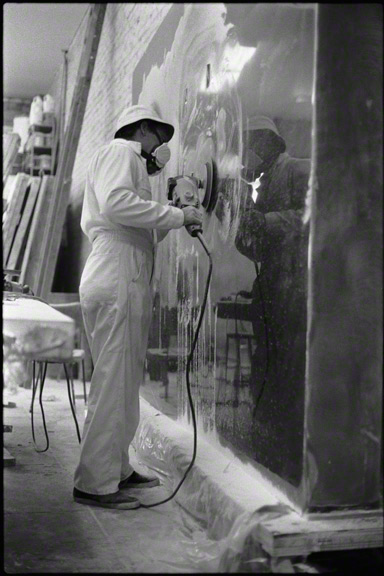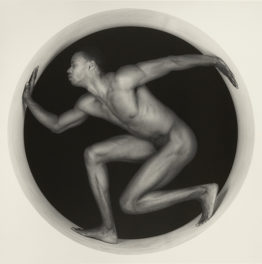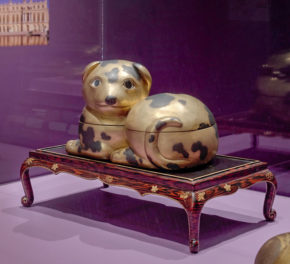
Gray Column, De Wain Valentine, 1975–76, Polyester resin, 140 x 87 1/2 x 9 1/2 in. Lent by De Wain Valentine. Artwork © De Wain Valentine
One of the most influential sculptors active in Los Angeles in the 1960s and 1970s, De Wain Valentine is perhaps best known for his striking, semitransparent, and delicately colored large-scale polyester resin sculptures of simple geometric forms that interact intensely with the surrounding light.
As part of the Southern California-wide Pacific Standard Time initiative, the Getty Conservation Institute’s exhibition From Start to Finish: De Wain Valentine’s Gray Column, which features one of the largest of these, opens today at the Getty Center.
At twelve feet high, eight feet across, and about 3,500 lbs, Gray Column is one of the biggest artworks De Wain ever made with polyester resin. Though begun in 1975, it has never been publicly displayed—until now. It also has never before been displayed upright, as the artist intended.
I was in the gallery two weeks ago in the West Pavilion as Gray Column was getting a final polish after being installed. Everyone who sees the piece stops to look twice. The black, gray, and brown smoky-colored resin is striking in person—the deep reflective qualities of the surface are easy to get lost in—and the opacity of the lower body and transparent edges at the top add to its solemn beauty.
Seeing the piece fully realized, it’s interesting to hear about the challenges De Wain faced in finding a material that would allow him to realize his artistic vision. These seemed nearly insurmountable back in the ‘60s. De Wain told me a few weeks ago, “I always painted, I always made sculpture. I was always interested in making things, three-dimensional things. And I’d show slides of my work to people and they’d say ‘I think we like them, but what are they made of?’ And I’d say ‘plastics,’ and their eyes would roll and they’d say ‘We don’t show plastics.’”
Despite this early censure, De Wain was one of a number of artists in postwar L.A. who adopted new materials and highly innovative fabrication processes for their work. Many of these new materials were being developed for use in the aerospace, boat, automobile, and even surfboard industries.
De Wain turned to polyester resin, a newly declassified material that could be cast and polished to create sculpture with a stunning, pristine surface. But none of the commercially available polyester resins could do what De Wain dreamed of doing—the material couldn’t be used to create large volumes in a single pour. Anything more than a thin layer of resin would crack badly during the casting process due to the incredibly high levels of heat released on curing. Because of these challenges, only fairly small-scale sculptures could be created.
Unwilling to accept this limitation, De Wain pushed the boundaries between art and science. He partnered with Ed Revay, a local representative from PPG Industries’ resins division, and with much trial and error, the pair was able to develop a polyester resin that allowed De Wain to create, with a single pour of resin, luminous artworks of much larger proportions.

De Wain Valentine pouring the resin for Gray Column, 1975–76. © De Wain Valentine

De Wain Valentine checking the mold for Gray Column, 1975–76. © De Wain Valentine
There were several larger sculptures in the same vein cast before Gray Column was realized. Each mold, which was hand built, required ten drums of resin, to which De Wain added a small amount of catalyst. The heavy drums had to be poured into the mold continuously, and then the whole had to be cured—a dangerous process fraught with high heat, cracking resin, and fumes—as well as a lack of sleep. The process required two full days; pouring alone was 12 hours or so, De Wain recalls. And then the hand-sanding began…the surface had to be perfect.
“The more imperfect the surface, the more you look at the surface, and I want to look at the surface and look through the middle and see the other side as well,” explains De Wain.

De Wain Valentine sanding Gray Column, 1975–76. © De Wain Valentine
As for the number of cast polyester resin sculptures he made? “Well, the pieces that went wrong, there were maybe 30 or 40,” he remembers.
Gray Column is a striking example of one artist’s single-minded determination, and exemplifies the incredibly large scale on which De Wain could work with the new material he helped to develop. It’s an amazing accomplishment by any standard.
From Start to Finish also explores some of the practical and ethical issues linked to the conservation of Gray Column and work like it. The Conservation Institute is currently gathering information on the materials and working methods of many postwar artists known for utilizing a vast array of new resins, paints, and plastics, such as Peter Alexander, Larry Bell, Robert Irwin, Craig Kauffman, John McCracken, and Helen Pashgian. The exhibition and the wider research project are part of this ongoing project, known as the Modern and Contemporary Art Research initiative.
To see Gray Column in person, catch From Start to Finish in the Getty Center’s West Pavilion through March 11, 2012. Beginning October 1, you can also see another De Wain Valentine at the Getty: the survey exhibition Pacific Standard Time: Crosscurrents in L.A. Painting and Sculpture, 1945–1970 includes his Red Concave Circle.
And if you happen to be in New York, you can see another of De Wain’s L.A.–made pieces—Triple Disk Red Metal Flake – Black Edge from 1966—newly installed at the Museum of Modern Art.




Handsome to be sure. But so 70’s. I am glad this stuff is over.
Interesting. I think we’ll check it out this weekend. I have a 5 year old and a 3 year old and I want to get their reaction to the piece.
Hi, J. Is a Bird – Hope you enjoy the exhibition and your visit to the Getty! While you’re here, you might also want to check out the Family Room and the Central Garden – both are great for young children.
I was surprised by the beauty of this sculpture. The contrast between the dense area of the column and the translucent areas is intriguing. Favorite find: the duo of small, spotlit mini gray columns in the corner of the gallery.
I just finished posting my pictures of our visit to this piece. My biggest surprise was how reflective it is. Made for some nice pics.
Thanks for reminding me about the Family Room 🙂